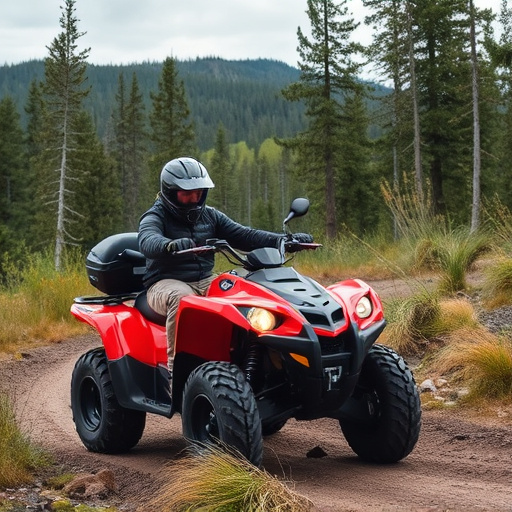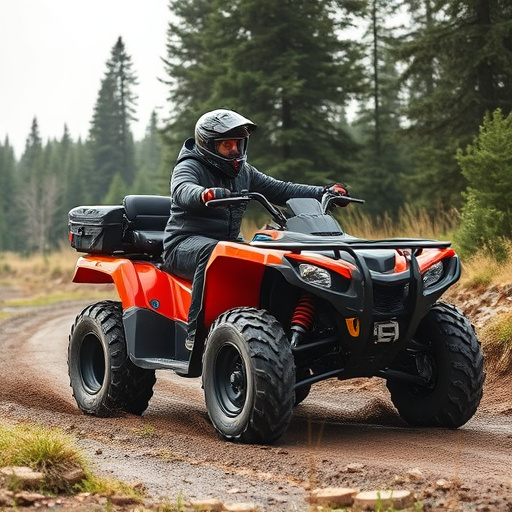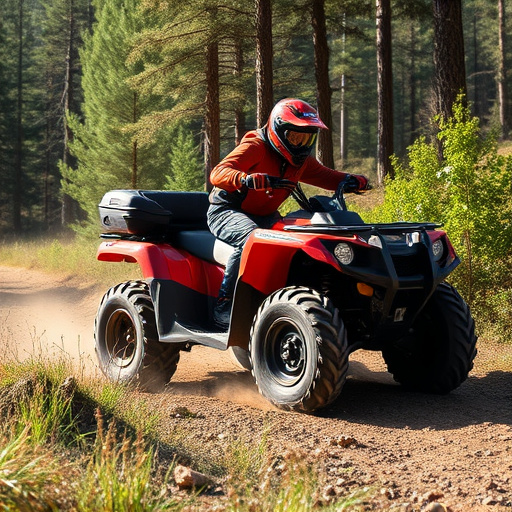ATVs rely on robust batteries for operation, with lead-acid and lithium-ion being primary choices. Lead-acid batteries are traditional, cost-effective but heavier and require more maintenance. Lithium-ion batteries offer lighter weight, higher power output, minimal maintenance, and longer lifespans. Key factors like battery type, capacity (Ah), and environmental conditions impact performance and longevity. Lithium-ion batteries are faster charging and have higher power density. Regular maintenance, such as cleaning terminals, monitoring charge levels, and suitable storage, is crucial for optimal ATV battery function. Choosing the right ATV battery based on voltage, Ah rating, climate, usage, and maintenance requirements ensures top-notch performance and prolongs the vehicle's lifespan.
Looking to boost your all-terrain vehicle’s (ATV) performance? Understanding the nuances of ATV batteries is crucial. This comprehensive guide delves into the core aspects shaping your ATV’s power source, from types and functionality to climate impact and maintenance tips. We pit lead-acid against lithium-ion batteries, explore terrain considerations, and offer a strategic selection process for choosing the perfect ATV battery. Maximize your ride with informed knowledge on atv batteries.
- Understanding ATV Batteries: Types and Basic Functionality
- Key Factors Influencing ATV Battery Performance
- Deep Dive: Lead-Acid vs Lithium-Ion ATV Batteries
- Impact of Climate and Terrain on Battery Life
- Maintenance and Care for Optimal ATV Battery Performance
- Choosing the Right ATV Battery: A Comprehensive Guide
Understanding ATV Batteries: Types and Basic Functionality

ATV batteries are a crucial component in ensuring your all-terrain vehicle (ATV) runs smoothly and efficiently. Understanding their types and basic functionality is essential when considering performance differences. ATVs typically use either lead-acid or lithium-ion batteries, each with distinct characteristics. Lead-acid batteries have been the traditional choice due to their lower cost and widespread availability. However, they tend to be heavier, require more maintenance, and have a shorter lifespan compared to lithium-ion alternatives.
Lithium-ion batteries, on the other hand, offer several advantages. They are lighter in weight, provide higher power output, and can withstand more charging cycles before degradation. These batteries also require minimal maintenance and have a longer overall lifespan. When considering performance, lithium-ion ATV batteries excel in extreme conditions, offering consistent power delivery even in hot or cold environments, making them a popular choice for those who demand optimal ATV performance.
Key Factors Influencing ATV Battery Performance

Several key factors significantly influence ATV (all-terrain vehicle) battery performance, impacting both its longevity and power output. One of the primary considerations is the type of battery used—whether it’s lead-acid, lithium-ion, or AGM (Absorbent Glass Mat). Each has distinct characteristics affecting performance; for instance, lithium-ion batteries offer superior power density and faster charging times but are generally more expensive.
Another crucial aspect is the capacity of the battery, measured in ampere-hours (Ah), which dictates how long it can supply a certain amount of power. Higher Ah ratings mean longer runtimes between charges. Additionally, environmental conditions play a role; extreme temperatures can affect battery performance and lifespan. Maintenance practices, such as regular charging and proper storage, are also vital to ensuring optimal ATV battery performance over time.
Deep Dive: Lead-Acid vs Lithium-Ion ATV Batteries

In the realm of ATV batteries, two prominent contenders stand out: lead-acid and lithium-ion. These technologies offer distinct performance characteristics that cater to various rider needs. Lead-acid batteries have long been the standard, known for their affordability and reliability in harsh conditions. However, they weigh heavier, require more maintenance with regular topping up, and may have a shorter lifespan compared to lithium-ion alternatives.
On the other hand, lithium-ion ATV batteries offer superior performance in terms of weight, as they are significantly lighter, providing better handling for all-terrain vehicles. They boast faster charging times and longer lifespans, making them a preferred choice for riders seeking efficiency and reduced maintenance. In today’s digital era, lithium-ion technology revolutionizes ATV power sources, enabling enhanced performance and ensuring a smoother, more enjoyable ride.
Impact of Climate and Terrain on Battery Life

The performance and longevity of ATV batteries are significantly influenced by environmental factors, particularly climate and terrain. Extreme temperatures can take a toll on these batteries, with both hot and cold conditions affecting their capacity and overall health. For instance, high heat can cause accelerated degradation, leading to reduced battery life, while cold climates may result in lower starting power due to the chemical reactions inside the battery slowing down.
Terrain plays a crucial role too. Rough, uneven terrain often leads to more frequent charging and discharging cycles, putting additional strain on the ATV battery. This constant stress can cause wear and tear, especially if the vehicle is used extensively for off-road adventures. On the other hand, smooth, consistent terrains might offer some relief, allowing the battery to maintain its charge more efficiently over time.
Maintenance and Care for Optimal ATV Battery Performance

Proper maintenance and care are essential for ensuring optimal ATV battery performance. Regular cleaning and inspection of the battery terminals can prevent corrosion buildup, which may cause poor connections and reduce overall efficiency. It’s also crucial to maintain a healthy charge level; deep discharging or overcharging can damage the battery and significantly impact its lifespan. Most ATV batteries require periodic charging, so keeping an eye on power levels and using smart charging solutions is key. Additionally, checking for any signs of damage, leaks, or swelling should be part of routine care, as these issues may indicate a need for replacement.
Storing your ATV battery properly when not in use is another critical aspect. Keeping it charged at around 50% capacity and storing it in a cool, dry place can extend its service life. Avoiding extreme temperatures and overloading the battery during storage are important considerations. Remember that proper care not only enhances performance but also ensures the longevity of your ATV’s power source, allowing you to enjoy uninterrupted riding experiences.
Choosing the Right ATV Battery: A Comprehensive Guide

Choosing the right ATV battery is crucial for optimal performance and longevity of your all-terrain vehicle (ATV). The first step involves understanding your ATV’s electrical requirements, which include its voltage and Ampere-hour (Ah) rating. Most ATVs use 12-volt batteries, but it’s essential to check your vehicle’s manual for the specific voltage and capacity needed.
Next, consider factors like climate, usage frequency, and charging habits. Extreme temperatures can impact battery performance, so choose a battery designed for your region’s climate. Regular use and quick charging cycles may require higher-capacity batteries, while occasional rides with longer charging intervals call for lower Ah ratings. Additionally, look into maintenance requirements; some batteries are easier to maintain than others, with varying levels of service life and warranty coverage.
In conclusion, choosing the right ATV battery involves understanding its types, key performance factors, and maintenance requirements. Whether it’s a lead-acid or lithium-ion battery, optimal performance depends on climate, terrain, and proper care. By following our comprehensive guide, you’ll be equipped to make an informed decision for your ATV’s longevity and efficiency.
